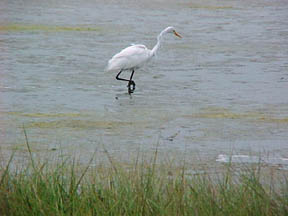|
zugunruhe September 3, 2002 |
|
|||||
|
|
||||||
|
For any migratory bird, preparing for migration means gaining weight and increasing fat reserves. From about 2 to 3 weeks before they leave and through the migration itself they eat like crazy (scientifically called hyperphagia - which roughly translated means lots of eating). And according to my stacks of books, not only do they eat a lot but some fall migrants who usually eat insects switch to berries and fruit for the extra carbs and lipids. Tree swallows usually eat bugs. Salt marsh mosquitoes seem to be a favorite dish. The skim along just above the water and catch mosquitoes and whatever all other bug life they can find in midair. But yesterday and today they all (all 12000+ of them) seemed to gravitate toward a few specific shrubs. Of course when every available inch of the shrub in question is covered with frantically flapping tree swallows, it's hard to tell what species of shrub it is. Can't see the leaves. Sure can't see the berries. It's still foggy and rainy today, which isn't helping with either plant or bird identification. There are plenty of bayberry bushes on Plum Island. So why do all 12,000+ tree swallows have to land on the same one at the same time? Surely the fact that they like to eat bayberries in fall doesn't explain it all. I have read (that darn library on my bedroom floor again) that even migrants that typically are not particularly gregarious flock together before or during migration. The theory is that the large groups help with avoiding predators, and maybe with finding food. Tree swallows are colonial anyway, roosting together at night. There's power in the union... obligatory Labor Day reference for yesterday.... The ornithological term for migratory restlessness is Zugunruhe. Even captive migratory birds get restless, rapidly fluttering their wings while perched, at the same time their wild brethren are gathering in flocks and eating fruit or whatever. So they like to be together, they like bayberries, and they're restless. That may be all the explanation I'm gonna get. Small shorebirds of all kinds are massing in great numbers wherever there's mud to dig bugs and worms and amphipods etc. out of. The egrets are restless and gathering into flocks too (though not by the thousands), but they seem to be eating fish. Even purple finches, which I think don't even migrate, seem to be gathering in flocks. Even students are migrating - we saw tons of returning students in Cambridge over the Labor Day weekend, shopping for bathroom rugs, mops, brooms, vacuum cleaners, and bookshelves. I don't think they're eating bayberries but they're surely experiencing zugunruhe. |
|
Today's Bird
Sightings This Year's Bird
Sightings
Today's Reading This Year's Reading Today's Starting
Pitcher(s) |
||||
|
|
Copyright © 2002, Janet I. Egan |
|||||
 I
had to go back and check on those tree swallows again. After
consulting my entire library for insight into what those
huge flocks of multi thousands of tree swallows were up to
swirling around and landing or attempting to land all on the
same shrub when there are perfectly good trees all around
it, I found a clue in Sibley. According to Sibley, tree
swallows are one of few species that can digest the wax in
bayberries and they gather into huge flocks and funnel down
onto bayberry bushes for a feast in the fall. Armed with
that clue, I wanted to catch them in the act of eating
bayberries today.
I
had to go back and check on those tree swallows again. After
consulting my entire library for insight into what those
huge flocks of multi thousands of tree swallows were up to
swirling around and landing or attempting to land all on the
same shrub when there are perfectly good trees all around
it, I found a clue in Sibley. According to Sibley, tree
swallows are one of few species that can digest the wax in
bayberries and they gather into huge flocks and funnel down
onto bayberry bushes for a feast in the fall. Armed with
that clue, I wanted to catch them in the act of eating
bayberries today.